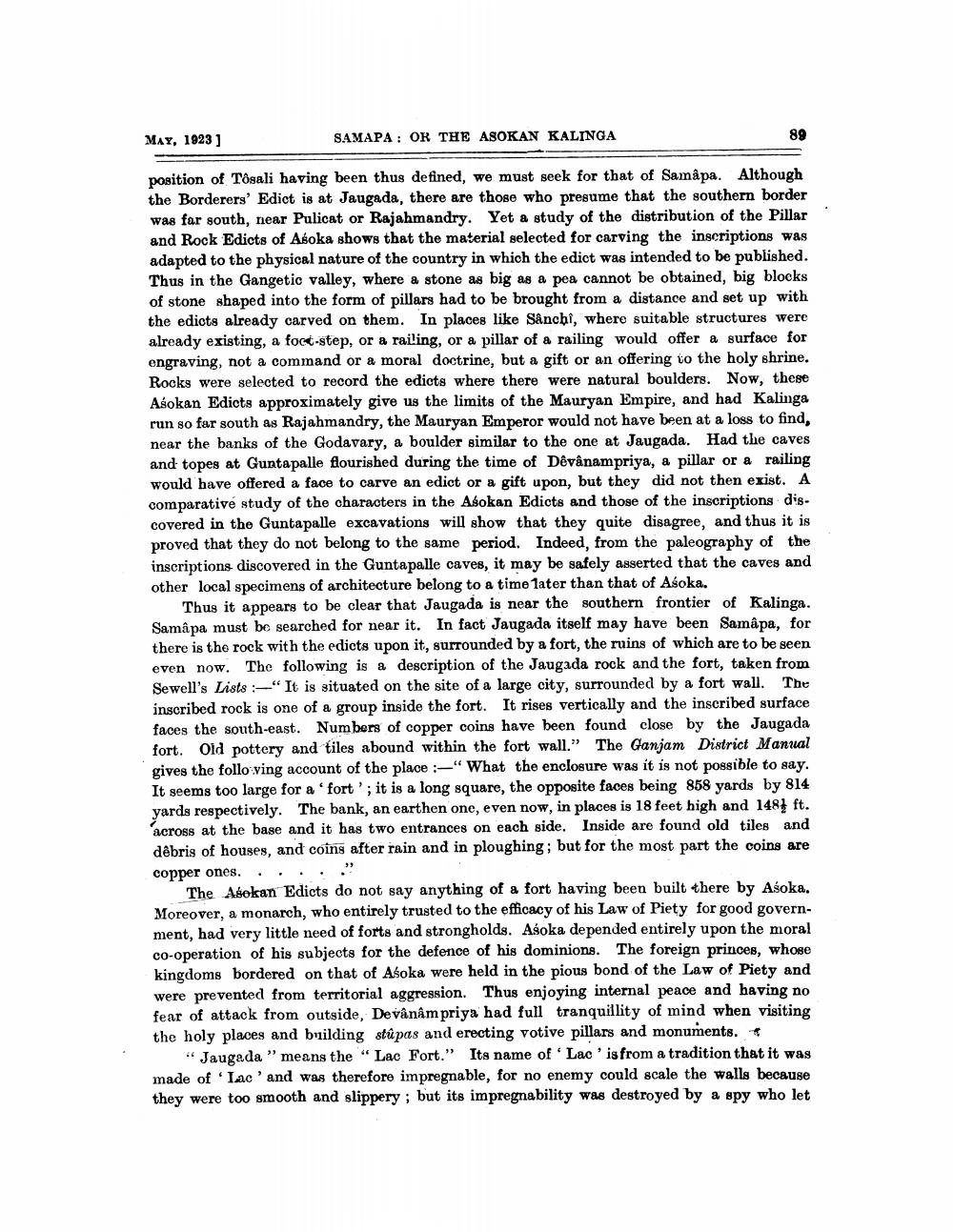________________
SAMAPA OR THE ASOKAN KALINGA
89
MAY, 1923]
position of Tôsali having been thus defined, we must seek for that of Samâpa. Although the Borderers' Edict is at Jaugada, there are those who presume that the southern border was far south, near Pulicat or Rajahmandry. Yet a study of the distribution of the Pillar and Rock Edicts of Asoka shows that the material selected for carving the inscriptions was adapted to the physical nature of the country in which the edict was intended to be published. Thus in the Gangetic valley, where a stone as big as a pea cannot be obtained, big blocks of stone shaped into the form of pillars had to be brought from a distance and set up with the edicts already carved on them. In places like Sânchi, where suitable structures were already existing, a foct-step, or a railing, or a pillar of a railing would offer a surface for engraving, not a command or a moral doctrine, but a gift or an offering to the holy shrine. Rocks were selected to record the edicts where there were natural boulders. Now, these Asokan Edicts approximately give us the limits of the Mauryan Empire, and had Kalinga run so far south as Rajahmandry, the Mauryan Emperor would not have been at a loss to find, near the banks of the Godavary, a boulder similar to the one at Jaugada. Had the caves and topes at Guntapalle flourished during the time of Dêvânampriya, a pillar or a railing would have offered a face to carve an edict or a gift upon, but they did not then exist. A comparative study of the characters in the Aśokan Edicts and those of the inscriptions discovered in the Guntapalle excavations will show that they quite disagree, and thus it is proved that they do not belong to the same period. Indeed, from the paleography of the inscriptions discovered in the Guntapalle caves, it may be safely asserted that the caves and other local specimens of architecture belong to a time later than that of Asoka.
Thus it appears to be clear that Jaugada is near the southern frontier of Kalinga. Samâpa must be searched for near it. In fact Jaugada itself may have been Samâpa, for there is the rock with the edicts upon it, surrounded by a fort, the ruins of which are to be seen even now. The following is a description of the Jaugada rock and the fort, taken from Sewell's Lists" It is situated on the site of a large city, surrounded by a fort wall. The inscribed rock is one of a group inside the fort. It rises vertically and the inscribed surface faces the south-east. Numbers of copper coins have been found close by the Jaugada fort. Old pottery and tiles abound within the fort wall." The Ganjam District Manual gives the follo ving account of the place :-"What the enclosure was it is not possible to say. It seems too large for a 'fort'; it is a long square, the opposite faces being 858 yards by 814 yards respectively. The bank, an earthen one, even now, in places is 18 feet high and 148 ft. across at the base and it has two entrances on each side. Inside are found old tiles and dêbris of houses, and coins after rain and in ploughing; but for the most part the coins are copper ones.
The Asokan Edicts do not say anything of a fort having been built there by Aśoka. Moreover, a monarch, who entirely trusted to the efficacy of his Law of Piety for good government, had very little need of forts and strongholds. Asoka depended entirely upon the moral co-operation of his subjects for the defence of his dominions. The foreign princes, whose kingdoms bordered on that of Aśoka were held in the pious bond of the Law of Piety and were prevented from territorial aggression. Thus enjoying internal peace and having no fear of attack from outside, Devânâm priya had full tranquillity of mind when visiting the holy places and building stúpas and erecting votive pillars and monuments.<
"Jaugada" means the "Lac Fort." Its name of Lac' is from a tradition that it was made of Lac' and was therefore impregnable, for no enemy could scale the walls because they were too smooth and slippery; but its impregnability was destroyed by a spy who let




